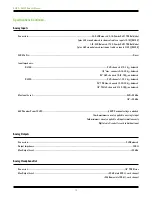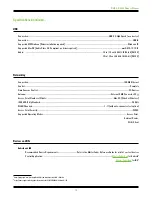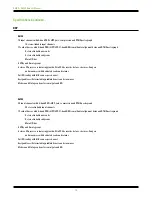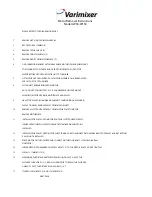
DL16S • DL32S Owner’s Manual
28
Glossary Of Terms Continued...
Mute Groups
— Mute groups allow you to quickly mute (and unmute) multiple channels and/or outputs with a single tap.
There are a multitude of possibilities in which to assign and enable mute groups: productions featuring a rotating cast
of musicians, theater productions, a house of worship and more. It is also great for muting all inputs during song breaks
or in-between sets. You may create as many as four separate mute groups with Master Fader.
Noise
— Whatever you don’t want to hear. This could be hum, buzz or hiss; or it could be crosstalk, digital hash,
or your neighbor’s stereo; or it could be white noise, pink noise or brown noise. It’s also how your parents describe
your band. After all, it’s what they don’t want to hear.
Noise Floor
— The residual level of noise in any system. In a well-designed mixer (such as the DL Series mixers), the noise
floor will be a quiet hiss, which is the thermal noise generated by electrons bouncing around in resistors and semiconductor
junctions. The lower the noise floor and the higher the headroom, the more usable dynamic range a system has.
Nyquist Sampling Theorem
— This theorem states that, when an analog signal is converted to a digital signal, it must be sampled
at a frequency that is at least twice the highest audio frequency present in the analog signal. If the audio frequency should
exceed one-half the sampling frequency, aliasing may result. Thus, if an analog-to-digital converter is sampling at 44.1 kHz,
the audio signal should not exceed 22.05 kHz.
PA
— Acronym for Public Address. Today, people who work with PA systems like to say they’re working in “sound reinforcement”.
See SR.
Pan
— Pan sliders are used to position (or even dynamically move) a monaural sound source in a stereo mixing field by adjusting
the source’s volume between the left and right channels. Our brains sense stereo position by hearing this difference in loudness
when the sound strikes each ear, taking into account time delay, spectrum, ambient reverberation and other cues.
Peaking
— The opposite of dipping. A peak is an EQ curve that looks like a hill, or a peak. Peaking with an equalizer amplifies
a band of frequencies.
PFL
— An acronym for Pre-Fade Listen. Broadcasters call it cueing. Sound folks call it being able to solo a channel
with the fader down.
Phantom Power
— A system of providing electrical power for condenser microphones (and some electronic pickup devices)
from the microphone input jack. The system is called phantom because the power is carried on a standard microphone audio
wiring in a way that is “invisible” to ordinary dynamic microphones. The DL Series mixers use a st48 volt DC power,
switchable on or off.
Generally, phantom power is safe to use with non-condenser microphones, as well, especially dynamic microphones.
However, unbalanced microphones, some electronic equipment (such as some wireless microphone receivers)
and some ribbon microphones can short out the phantom power and be severely damaged.
Phase
— The time relationship between two signals, expressed in degrees around a circle. 0˚ and 360˚ represent an in-phase
relationship. Both signals change in the same way at the same time. Anything else is out of phase.
180˚ out-of-phase is a special case which, for a continuous waveform, means that at any given time the two signals have
the same amplitude but are opposite in polarity. The two legs of a differential output are 180˚ out-of-phase. The polarity
invert button (found in the EQ view) reverses the signal polarity.
When out-of-phase signals are mixed, there will be some cancellation at certain frequencies, the frequencies and the degree
of cancellation being a function of the amount of phase shift and the relative amplitude of the signals. Attention to mic
placement and careful listening will allow you to use this effect creatively.
Post Fader
— A term used to describe an aux send (or other output) that is connected so that it is affected by the setting
of the associated channel fader. Sends connected this way are typically (but not always) used for effects. A post-fader
output from a mixer channel is usually post-EQ.
Содержание DL16S
Страница 1: ...OWNER S MANUAL ...





































